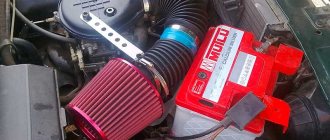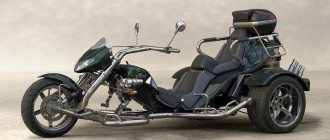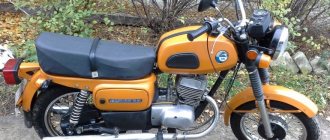Almost all car enthusiasts have a desire to increase the power and dynamics of their car. At the same time, everyone uses their own methods, based on capabilities and level of knowledge.
Some optimize the engine, others install various body kits and spoilers, others use high-quality consumables, and so on.
But experienced car owners know about another popular method - installing a zero-resistance filter.
So what is this device? What are the differences between “nulevik” and standard filters? Is there any point in spending money? Let's figure it out.
What is a zero resistance filter for and where is it used?
The task of the air filter installed in each car is to clean the flows entering the engine from various “garbage”. But this is a double-edged sword.
On the one hand, installing a filter allows you to clean the air, and on the other hand, it creates additional resistance to the flow.
The result is a decrease in power, which is especially noticeable as the filter element becomes dirty.
Zero resistance filter is an alternative to the classic filter. The main purpose is to reduce the overall air resistance without compromising the quality of cleaning.
It is believed that installing such a filter can increase engine power by an average of 5-7%. At the same time, there is almost no way to feel the difference from installation. All that remains are facts that you have to believe.
“Nuleviki” are actively used on sports cars with the same purpose - to add power to the power unit. At the same time, any alternatives are not even considered.
But it is worth considering that the difference between sports cars is not only in the installation of a special filter, but also in a more advanced exhaust system, which allows the release of large volumes of exhaust gases even at maximum speed.
Sooner or later, almost every motorcyclist asks the question of zero-resistance filters: sports riders want to go even faster, the rest do not want to lag behind the sports riders. “Nuleviki” are one of the most important topics for holivars on the forums, and here, at everyone’s favorite bikepost. Some say that this is the certain death of the engine, others responsibly declare - nothing like that. Well, I decided to check how it really is. After studying thematic forums on X-4, I came to the conclusion that the K&N zero in a standard airbox is not my option, the suction pipe has a rather small cross-section, and it is unlikely, I thought, to reveal its full potential. While getting caught up in another forum thread, I learned that “KaENs” filter only flies, and in general. Therefore, I decided to purchase “racially correct” UNI. Set of four. I took it from my hands, not used, on the same forum. In addition to them, I got 130/135 jets (stock - 108/115). The parcel arrived quickly, from the post office I taxied to a motorcycle store, where I purchased liquid for impregnating filters from the controversial company Motul. I arrived at a friend’s garage, and away we go...
First of all, the jets and float chambers of the carburetors were inspected. No dinojet, promised by the former owner of the spendthrift, was found. The jets are stock, the carbs are clean, the rubber bands are in order. We loaded the 135/130 jets into an ultrasonic washer for 10 minutes, and at the same time the XX jets went there. It's a funny thing, I'll tell you, this ultrasonic washer. It buzzes, boils, and seems to be cleaning. I didn’t try it with my finger, although the owner advised me to “feel the water” with a sly smile.
After installing the new jets in place and screwing the carburetor bar back into the motorcycle, we began to experience zen: the filters did not want to get into their rightful places, the frame and airbox were in the way, which I decided to leave “just in case.” But the zeros perfectly change their head start, to the detriment of appearance and their own suction area, and therefore were mounted in place. I would like to make a special mention of Motul impregnation liquid: it’s a hellishly sticky thing, I think if you spray it on toilet paper it will make a good trap for flies.
They collected it and started it. The speed is maintained at about 900. The XX shifter was rotated 90 degrees, which is how we achieved the manual 1100 rpm. And at the same time, we synchronized the carbs, so that everything would be completely human.
And the best part: the results. Mot drove faster. Not “AH!”, not even “Wow!”, but, you know, such a solid “However...”. It spins up more willingly, the sound has changed, the intake has become audible, just like on the muscle cars I adore. What’s interesting is that the brains from the blackbird (put it on the X to shift the cutoff) didn’t like the new feature at all. I returned the ECU to stock. I haven’t driven much yet, about 100 km. We’ll find out in a couple of months what will happen next, and what effect “nuleviks” have during long-term use.
How is it different from other types of filters?
The main difference between the “nulevik” lies in its design. Classic filters installed on most cars are made of paper (more precisely, from compressed fibers).
The flow of air masses passes through small holes in the fibers, and then goes to the motor.
As soon as the fibers become clogged, the resistance also increases, because the air needs to find new ways to overcome the obstacle. If you do nothing, the engine power drops.
Taking into account existing standards, the paper filter must have a large thickness with maximum fiber compression. This design ensures high-quality cleaning, but the resistance is increased immediately after installation.
The design of the “nulevik” is based on the principle of reducing resistance.
The device is based on several layers of cotton, which effectively traps dust and dirt. In this case, the retained particles essentially become part of the product.
Thanks to this, the efficiency of the filter element is higher and one square centimeter of surface accepts more dust than its predecessor.
Cotton fabric is sandwiched in an aluminum screen, which increases the filter surface. The developers claim that the working part of the “nulevik” is 4-5 times larger than in a classic filter, which ensures a long service life and lower resistance of the product.
This is achieved thanks to another factor - the presence of a special coating (oil) on the cotton, which traps dirt without harming the flow.
Is it possible to put a replica in the stock Federal Tax Service?
In the automotive spare parts market, you can increasingly find inexpensive counterfeits made in China or Turkey. And to many motorcycle owners, such a purchase seems justified, because the original is not cheap. In fact, a good scooter made in Europe or Japan has high technical characteristics. Such models cannot be improved by replacing just one part; an integrated approach is needed. At the same time, one counterfeit spare part can lead to damage to the unit and a deterioration in its operating capabilities. It is best to purchase “nuleviks” from trusted brands: Prosport, Green Filter, Pipercross, Apexi, SCT, K&N, Simota.
Cheap “zero” leads to the following:
- they resemble the original filter in appearance, but are several times cheaper;
- such details are not filtered properly;
- all particles of dirt and dust penetrate the carburetor;
- the engine becomes clogged with dirt;
- dust and dirt in the cylinder lead to rapid wear of the DSP elements, as they turn into abrasive.
Having installed a fake, you will hear a characteristic loud and “aggressive” roar, which is evidence not of an increase in power, but of the imminent failure of the central station.
The principle of operation of the filter, its features
The operating principle of the “nulevik” is based on two factors:
- high-quality cleaning of the flow entering the motor;
- minimum air resistance.
The effectiveness of the zero resistance filter is due to its unique design and the use of cotton (rather than paper) material.
The incoming flow is filtered from dust without causing any significant contamination to the product. Thanks to special impregnation, particles entering through the filter settle on the surface and do not interfere with the flow of air to the combustion chamber.
As a result, a sufficient volume of air enters the intake manifold, and the power of the power unit increases.
Pros and cons of installing in a regular place
The advantages include the absence of changes in appearance and design integrity. The standard location is usually hidden by the manufacturer under covers, and the filter is not visible from the outside.
But there are many more disadvantages:
- Hidden installation of the filter under the housings prevents full access of air to the filter. For zero engines this is especially critical, because their purpose is lost - to give the engine as much air as possible.
- In addition, installing the filter under the housing requires the use of an air duct, which is a flexible rubber pipe that runs from the filter to the intake manifold, which integrates the intake, carburetor and cylinder.
- Due to the design features, the air duct most often has a curved shape, so the air flow in it changes direction. Passing through such a pipe also creates resistance to flow. To improve performance, a direct-flow filter for the carburetor is best suited. This type of zero does not require an air duct, has open access to ambient air and is the most efficient.
Advantages and disadvantages of “nuleviks”
As practice shows, such filters have their positive and negative qualities.
Let's start with the pros:
- increase in power by 5-7%. Of course, this may not be noticeable to the driver, but when installed in combination with other types of engine tuning, the result can be felt for yourself;
- changing the sound characteristics of the motor. It is believed that the filter element makes a special sound, which changes the general hum from the engine compartment. Many car enthusiasts install “nuleviks” precisely for this reason;
- The appearance of the space under the hood changes - it becomes more sporty.
Disadvantages of "nulevik":
- the need for constant maintenance, which not all car owners like to do;
- affordable filters are of low quality, so they clog almost immediately. The oil also becomes contaminated faster, which leads to a decrease in the life of the power unit.
Original filters on scooters
A stock engine, even with the original “zero”, will also not be able to please with improved performance. It is not intended for such a tuning element, since the throughput qualities of the Federal Tax Service are much higher than those of the stock analogue. This kind of installation can lead to a lean air-fuel mixture. The consequences of such tuning: loss of power capabilities of the unit, frequent overheating and other troubles.
It can only be installed if at least partial tuning of the engine itself has been carried out, as well as carburetor settings.
How to care for such filters?
As already mentioned, one of the main disadvantages of the filter is the need for regular maintenance.
After purchasing and installing the product, it must be washed and treated regularly. In this case, processing according to the “remove-wash-install” principle will no longer work - a special algorithm is required here.
The frequency of washing is every 5-6 thousand kilometers. If the car is operated in dusty areas or off-road, then the filter must be cleaned more often.
If you forget about servicing the device, the machine becomes “gluttonous” and “dumb.”
The algorithm of actions is as follows:
- remove the zero filter from the machine and remove all dust from it using a special brush;
- Wash the unit in a special container with a special cleaning solution, then rinse the filter under water pressure;
- shake off the filter element and inspect it. If there are light spots, the filter needs to be impregnated with a special agent;
- treat the product with a special impregnation (as a rule, it is sold separately from the “nulevik”);
- return the “zero” to its original place.
There are even special kits for caring for “nuleviks”, which include washing and impregnation. A few manipulations as described above, and the product looks like new.
Please note that the total number of washes can be limited and is about 20 pieces. After this, it is worth installing a new filter.
Installation Features
Many car enthusiasts make a big mistake - they install the “zero” incorrectly, which is why it is not able to perform its functions normally.
For example, the filter is installed too close to a hot engine or exhaust manifold. Here it’s time to remember physics.
The density of cold air is higher than that of hot air. As a result, it is easier to “push” cold air into the combustion chamber than hot air.
Therefore, the “nulevik” should be located as far as possible from any heat sources (motor, exhaust manifold, etc.).
In addition, it is not recommended to install the filter in the lower part of the engine compartment. In such a situation, the product will quickly become dirty and lose its best qualities.
In addition, a dirty filter will have to be “repaired”, which will also take some time.
Today there are a lot of models of zero filters that are designed for installation on various types of cars - with an injector or a carburetor.
The material can be mesh, foam rubber or cotton. Filters made of foam rubber have the highest degree of purification, but they also have more resistance than their “brothers”.
Installation of the “nulevik” on different cars is done differently, but in general you need to follow the following algorithm:
- discard the connector from the MAF (mass fuel flow sensor);
- use a screwdriver to disconnect the rubber tube from the air flow sensor;
- remove the sensor fasteners from the body (to do this you will have to unscrew a couple of bolts);
- dismantle the case and remove the rubber clamps (use duckbills or pliers);
- unscrew the fastener from the group of wires;
- fasten a pair of bolts from the mass air flow sensor clamp to the “zero” fastener;
- Place a new filter on the mass air flow sensor, tighten the clamping clamp and connect the sensor.
That's all, the new filter is installed on the car.
How to make a zero filter with your own hands?
Some car enthusiasts, in a desire to save money, decide to make a “nulevik” with their own hands.
The source is a factory round filter, which was once installed on Moskvich cars.
To make a “nulevik” you can use different methods. We will describe one of them below.
You will need available tools (foam rubber, sealant, sharp knife, glue and others). The total price of the issue is no more than 3-4 US dollars.
It’s worth noting right away that a converted “zero” is unlikely to add power to your car. The reason is outdated technologies that were used in the production of cars in the 70-80s.
When creating filters, manufacturers thought little about the importance of cleaning, so old products only retain very large pieces of dirt. So, by “creating” a zero filter, you are taking a certain risk and can “kill” your engine.
By the way, the only car where such a zero filter would be “at home” is the Moskvich. At the same time, there are owners who immediately cut off the walls to eliminate excess flow resistance.
If you decide to experiment, the sequence will be as follows:
- remove the standard device;
- Make a rectangular adapter with a hole from a piece of plywood.
Drill four more holes and fix the adapter to the air meter sensor.
Before doing this, install a piece of pipe into the hole and treat the cracks with sealant;
- Make additional holes in two plywood circles. At the same time, make a hole of a larger diameter on the outer circle, and on the inner circle (installed near the air meter) - according to the diameter of the pipe being installed. The latter shrinks using sealant;
- make 3 bars with a length of about 16-18 centimeters and use them to fasten the circles. The result will be a unique cylindrical shape. Since there is no plywood in the bars, it is necessary to make holes along the edges for installing self-tapping screws (otherwise the plywood may be damaged);
- To prevent the foam from falling out, make a body. To make it, you can take a mesh for GVL joints. The advantage is the presence of a sticky base, which allows for immediate fixation;
- then foam rubber is glued on the outside using thermosealant, which allows you to securely and quickly fix the device;
- fix a couple of pieces of foam rubber for the side of the barrel with sealant;
- put on foam rubber and fasten the plywood beams with ties.
There are simpler solutions.
Reviews
The best indicator of the need to install such a device is reviews from real car enthusiasts. Here are some of them:
Anton, Belgorod.
“I’ve been driving with a zero car for a long time. I did the intake and exhaust at the same time, so the result was significant (like after a good engine chipping). If you install a zero filter on a regular car with normal settings, there will be no result.”
Egor, Kazan.
“I didn’t feel any effect from installing a zero filter. What can be changed by installing a piece of rag?!”
Mikhail, Smolensk.
“When you turn off the engine, there is a unique suction sound that adds to the “sportiness” of the car. I installed a “zero” on the Galant and am pleased. The car felt faster.”











